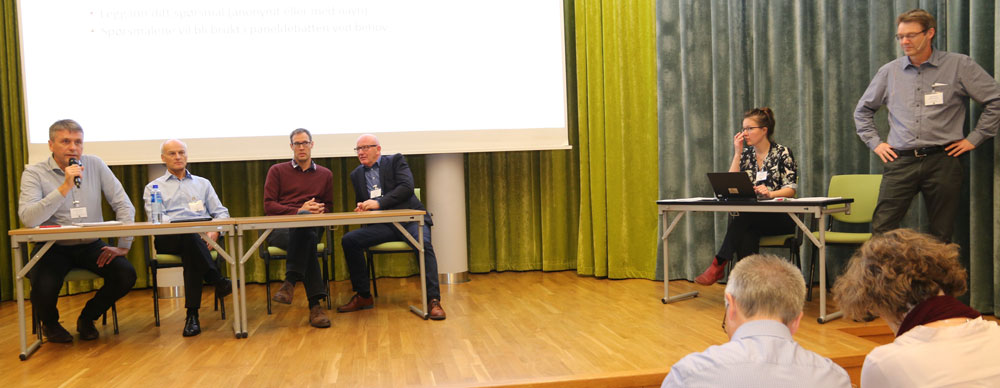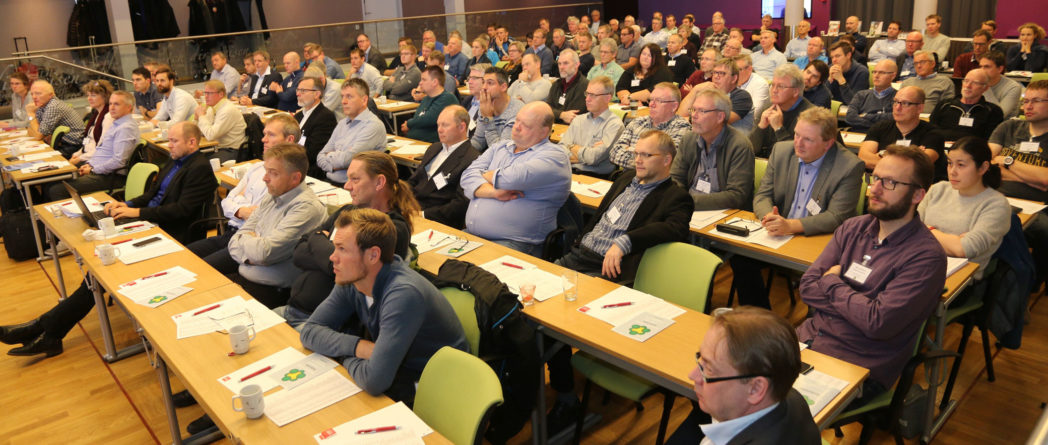- Previously published in Energiteknikk in Norwegian in November 2017. Text and photo: Stein Arne Bakken.
The SF6-insulated Substation User Group holds a meeting every two years, the most recent being a two-day event in Oslo at the beginning of November 2017. Magne Runde, a Senior Research Scientist at SINTEF Energy Research, was invited to provide the 115 participants with an insight into what is happening with regard to the development of alternative solutions and new technology for such substations.
Runde pointed out that SF6 gas is unsurpassed as regards the properties required in high voltage substations. These include its electrical insulation ability, in other words, high dielectric strength, its ability to cool and extinguish arcing in switches, and its ability to remove heat produced by ohmic (resistive) heating in conductors.
In addition, the gas must not be toxic or harmful to the environment. It must be compatible with other materials in the substation, should not be “consumed” by an electric arc, and must not cause the cost of a substation to be too high.
For substations rated at up to 145 kV, methods have been developed using alternative gases to replace SF6.
“The big challenge is to find gas types whose properties are good enough for even larger substations. Designing switchgear is a time-consuming and complex job when so many requirements have to be met,” Runde emphasised.
Four different gas types
He mentioned four gas types that have been launched in the market as potential alternatives to SF6: carbon dioxide (CO2), vacuum and air (a mixture of nitrogen and oxygen), as well as two groups of synthetic gases – fluoroketones and fluoronitriles.
The major suppliers, ABB, Siemens and General Electric (GE), have all developed their own solutions, and representatives of the companies presented these at the User Group meeting. They also participated in the panel debate after lunch on the first day of the meeting.

ABB uses CO2
According to Runde, CO2 is an acceptable insulating and arc-quenching gas and it has a number of other favourable properties. However, its dielectric strength is only one third of that of SF6 gas, whilst its circuit-breaking properties are only 60-80 per cent of those of SF6. ABB offers an outdoor 72.5 kV circuit breaker using CO2 that can withstand temperatures down to minus 50°C.
ABB has also chosen to invest in fluoroketones in its high voltage substations, in particular the C5 ketone product. Because ketone condenses to a liquid at 27°C at 1 bar atmospheric pressure, it is mixed with air and CO2. The gas has approximately the same insulating ability as FS6, but inferior circuit-breaking properties. It is also consumed when quenching an electric arc. ABB supplies such medium-voltage equipment, named AirPlus, for use in indoor substations and has carried out test installations of GIS equipment rated at up to 170 kV.
GE has chosen nitrile gas
The other fluorine-based gas, fluoronitrile, has approximately the same insulating and circuit-breaking properties as SF6. In pure form at 1 bar atmospheric pressure, it condenses to a liquid at minus 5°C. This gas is also consumed when quenching an electric arc. However, fluoronitrile is a greenhouse gas whose harmful effect is 2000 times that of CO2. GE markets substations with nitrile, as well as in a CO2 mixture, as ”g³ – Green Gas for Grid”. The gas is commercially available in substations rated at up to 145 kV, which can operate at temperatures down to minus 25-35°C.
Siemens is focusing on GIC substations using vacuum switches and pure air as an insulating gas. The company markets such installations rated at up to 145 kV. According to Runde, this is the best solution for the environment, but at high voltages such substations become large and expensive. Four vacuum switches are needed to achieve voltages of 420 kV.
Game over for SF6
“The challenge for the energy generators will be to keep track of all the gas mixtures and different temperature conditions in future GIS substations,” said Runde, “In particular, this will complicate maintenance and condition inspection of the substations.”
Runde made it clear that it is “game over” for the use of SF6 gas in medium-voltage substations in future. There are already good alternatives in this field. However, many problems remain to be solved as regards the use of alternative gases at higher voltage ratings. He does not believe that all the concepts will survive but that the suppliers will unite behind a small number of gas mixtures. Universal standards will develop in time. Clients will choose environmentally-friendly substations and will be willing to accept that these take up more space and cost more.









Comments
Are there any recent updates about the numbers of the SF6 Insulated Substation User Group? Is there a member list available?
Here is the memberlist: https://www.sintef.no/prosjekter/1991/brukergruppen-for-sf6-anlegg/om-brukergruppen/medlemmer/#menu